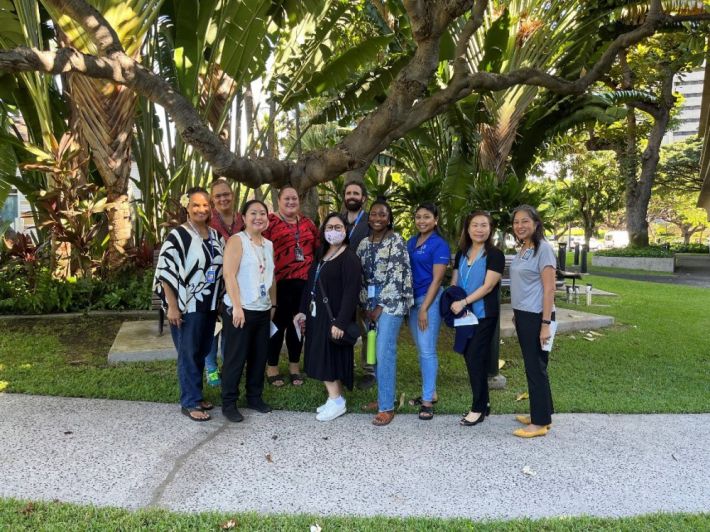A small group of Kawaiahaʻo Plaza staffers took a trip back in time to explore the era of the arrival of the missionaries, their impact on Hawaiʻi and their relationships with Hawaiʻi’s aliʻi from 1820 through the early 1900s.
The huakaʻi to the Hawaiian Mission Houses, a Kawaiahaʻo Plaza neighbor, was made available by the KS Hoʻokahua Cultural Vibrancy Group and the Office of the CEO to encourage our KP employees (old and new) to learn about Hawaiʻi’s rich culture and history. This visit was one of two huakaʻi sites, the other was ʻIolani Palace.
The Hawaiian Mission Houses huakaʻi was led by Kehau Peʻa, cultural specialist of the Hoʻokahua Cultural Vibrancy Group. Staff members from Nakiakaulani – Legal, Internal Audit, EIMS, LIMS, Hoʻokahua and Communications were able to hoʻolauna and offer oli to the HMH staff members.
Archivist Molly Rowe shared artifacts that included the oldest hymnal, bible, and palace invitations. Early photographs produced on a silver or silver-covered copper plate call daguerreotype photos brought faces to life, and a report card showing the progress of Margaret Nape, a student at the KS School for Girls featured her graded subjects such as algebra, choral, civics, cooking, drawing, English, housework, nursing, physical education, piano, sewing and conduct.
Perhaps one of the biggest contributions by the missionaries was the creation of a written Hawaiian alphabet to translate the bible in ‘ōlelo Hawaiʻi. With the creation of religious materials as well as educational materials, Hawaiʻi became the most literate nation in the world.
“Our visit made me appreciate the global competence our ali‘i were able to develop with the technology available at that time,” said Chantal Kainani Cruz, legal assistant/paralegal in Nakiakaulani. “In addition to being versed in the Hawaiian ways, our ali`i knew they also had to learn foreign languages, policy, and western business practices in order to establish and maintain a foothold in the (then) new world.”

The huakaʻi was led by Kehau Peʻa, cultural specialist of the Hoʻokahua Cultural Vibrancy Group. Staff members from Nakiakaulani – Legal, Internal Audit, EIMS, LIMS, Hoʻokahua and Communications were able to hoʻolauna and offer oli to the HMH staff members.

KP staffers explored the era of the arrival of the missionaries, their impact on Hawaiʻi and their relationships with Hawaiʻi’s aliʻi from 1820 through the early 1900s.

Archivist Molly Rowe shared artifacts that included the oldest hymnal, bible, and palace invitations.

Early photographs produced on a silver or silver-covered copper plate call daguerreotype photos brought faces to life.
TAGS
hawaiian culture,
hawaiian history,
our employee 'ohana
CATEGORIES
Kaipuolono Article, Regions, Themes, Culture, Community, Employee ‘Ohana, Ka ʻohana Kamehameha, Newsroom, Department News, Ho‘okahua
Print with photos
Print text only










